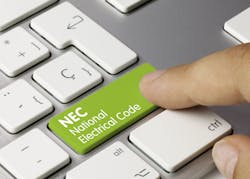Top Changes to the 2023 NEC That Impact Electrical Contractors
In one of the first educational sessions of this year’s NECA convention and trade show, Mark W. Earley, P.E., from the Alumni Code Consulting Group LLC, presented on the most significant changes to the 2023 National Electrical Code. “It’s like we went through the 2023 Handbook with a paint roller,” Earley remarked about the unusually large quantity of changes to the latest edition compared to past revisions. The 2023 version saw nine new Articles, three deleted Articles [Arts. 510, 720, and 712], seven Articles with title revisions, and four relocated Articles.
Here are some of the highlights he discussed in terms of NEC changes:
- Several reconditioned equipment requirements were added to the NEC. The most significant change is that the second section of some Articles (XX.2) is now reserved for any requirements that permit or prohibit reconditioning of equipment that is covered by the Article.
- Article 100 now homes all definitions and no longer has Parts.
- Section 210.19 details new branch circuit voltage limits for AC and DC circuits (1,000VAC and 1,500VDC). Requirements for branch circuits exceeding those limits were relocated to the new Art. 235.
- Medium- and high-voltage requirements have been moved to Articles ending in “5”: Arts. 235, 245, 305, 315, 395, and 495. Arts. 395 and 405 were relocated from Arts. 399 and 490, respectively, to match this labeling convention.
- Article 235 is brand new on branch circuits, feeders, and services, and corresponding requirements have been deleted from Arts. 210, 215, and 230.
- Article 245 is new to the 2023 NEC and covers overcurrent protection for systems rated more than 1,000VAC and 1,500VDC.
- Article 300 was reorganized to limit it to systems rated 1,000VAC nominal or less, and 1,500VDC nominal or less. Medium- and high-voltage requirements are moved to the brand-new Art. 305.
- Article 311 has been relocated to Art. 315.
- Article 722 is new and covers cable requirements for Class 2 and Class 3 power-limited circuits, power-limited fire alarm circuits, and Class 4 fault-managed power systems.
- Class 1 circuit requirements have been moved from Art. 725 to the new Art. 724.
- Art. 725 now only applies to Class 2 and 3 power-limited remote control and signaling circuits.
- New Art. 726 covers Class 4 power-limited circuits.
- The new title for Art. 810 has been changed to “Antenna Systems.”
- The definition of “commissioning” has been revised, with requirements moved to Secs. 700.3, 701.3, and 706.7.
- These sections on personnel safety saw revisions/additions in the 2023 NEC: Secs. 110.16(B), 110.22(A),110.26, 215.15, 225.41, and 408.4.
- The topic of cyber threats has seen increased coverage in the 2023 NEC, with new requirements in Sec. 110.3(A)(8) requiring the evaluation of cyber security for network-connected life-safety equipment.
- A new definition was added to Art. 100 on special purpose ground-fault circuit interrupters (SPGFCIs). Outlets and receptacles also saw NEC revisions in Secs. 210.8(A), 210.8(F), 210.52(C), 220.110, 406.12, and 680.5.
- Reconditioning requirements were revised in Sec. 110.17, stating that servicing must be provided by a “qualified person.” Secs. 110.20 and 517.6 were added to detail new requirements for reconditioning.
- These Sections detail requirements for electric vehicles: 220.53 [Appliance Load – Dwelling Units], 220.57 [Electric Vehicle Supply Equipment Load], 220.70 [Energy Management Systems], 625.49 [Island Mode].
- In Sec. 250.24, the term “high impedance grounded system” has been changed to impedance grounded system.”
- Article 369 is new and covers insulated bus pipe (Type IBP). The new Art. 371 covers flexible bus systems.
- Regarding conductor ampacity and motor rating determination, Sec. 430.6(A)(2)(3) was added, which permits the use of nameplate current ratings for motors that exceed the motor sizes in Part XIV.
- Section 690.12 now establishes requirements for the rapid shutdown of PV systems on buildings and features a new exception for non-enclosed detached structures.
About the Author
Ellie Coggins Angus
Ellie Coggins Angus is the managing editor for EC&M and was formerly the associate editor for Electrical Wholesaling. She has more than five years of experience in the B2B publishing space covering the electrical contracting/wholesaling industry. Ellie received an MA in journalism from Syracuse University and a BA in English from University of Cincinnati. She is currently based in Cincinnati, Ohio. Connect with her at [email protected] or on LinkedIn.

